Before the annual meting
I was invited by prof. White to attend the annual meeting of the Society for Neuroscience in 2023 (SfN2023). Flying from Netherlands to the United States to attend a conference opens the possibility to add a vacation in the States to the trip.
Before the conference I and my husband Hans had a wonderful trip to the Blue Ridge Mountains and the Great Smoky Mountains. We had a great time. Highlights were: the beautiful fall colours, the Foxfire Museum, the Cumberland Gap, the impressive Appalachian Mountains and the kind and above all the friendly people we met.
The annual meeting SfN2023
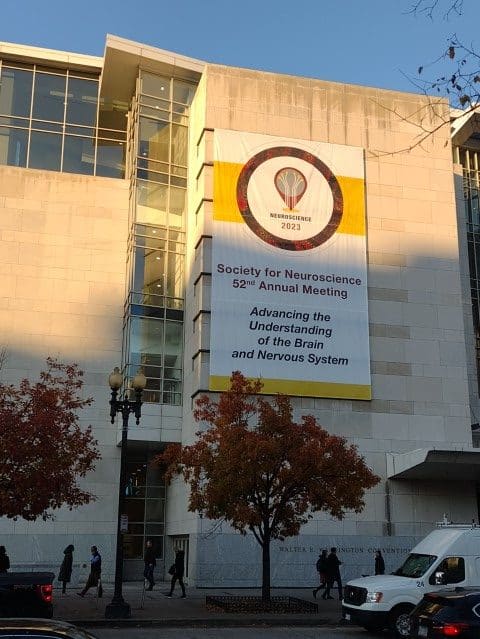
About 25,000 people attended the meeting from November 11th until November 16th in Washington DC. As a result Hotels are fully booked and so are restaurants. Therefore you have to make reservations well in advance. Attendees were everywhere. For example: Travelling back to the Netherlands in the subway to Dulles airport, a fellow traveller asked Ellen if she had been to the conference (she seemed familiar, which seems peculiar when there are so many visitors). He had been to the meeting, had presented a poster, and was full of it. On the plane to the Netherland there were quite some poster tubes around. Ellen asked two of their carriers to which meeting they had been; it was SfN2023.
SfN meetings are the largest events for neuroscientists in the world. There are Poster Sessions, Nano-, Mini-symposia and Symposia among other events like Clinical Roundtable meetings, Socials, Professional Development Workshops, and much more.
Posters at the annual meeting
There was an overwhelming amount of posters presented. Two posters were especially relevant to us. The one by Alexander Winn, a very enthusiastic and successful student of our online course, Medical Neuroscience.
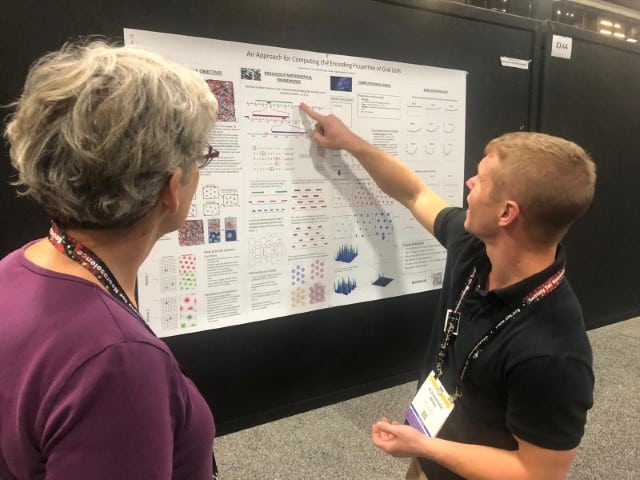
A multi-scale robust coding system in biology: the grid cells
And the one of Yuqi Tian, a graduate student of prof. White at Duke University.
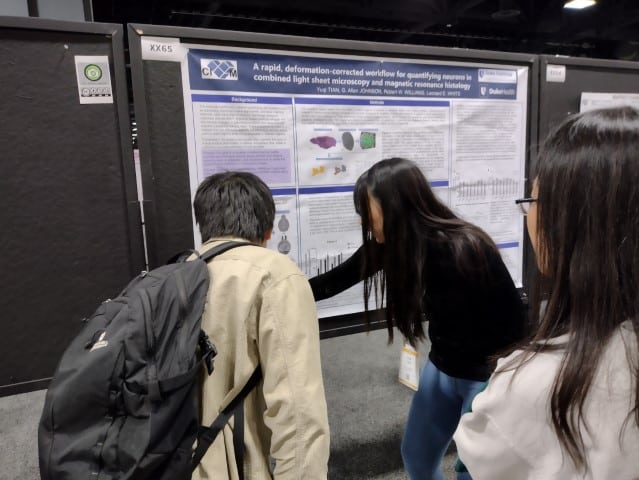
A rapid, deformation -corrected workflow for neuron counting in combined light sheet microscopy and magnetic resonance histology
Symposia, Mini symposia, Nano symposia at the annual meeting
There are different types of symposia: Symposia (audience size 500-1000; each presentation 35 minutes). Mini symposia (audience 500-1000; 20 minutes each presentation). Nano symposia (audience 200-600, 15 minutes each presentation).
Every day both Prof. White and I went to different Symposia and Lectures. Here are some highlights
The first day I went to the Nano symposium: Effects of COVID-19: Physiology and Cognition and later to the Symposium: Advances in the Neuroscientific Study of Consciousness: Novel Frameworks to Bridge the Gap Between Theories, Experiments and Clinical Relevance.
I had to leave the COVID symposium early to go to the Consciousness Symposium. But it was a very interesting symposium. Scientists developing a new field of science, exploring lines of research and defining boundaries of study. The scientists were especially inspiring each other.
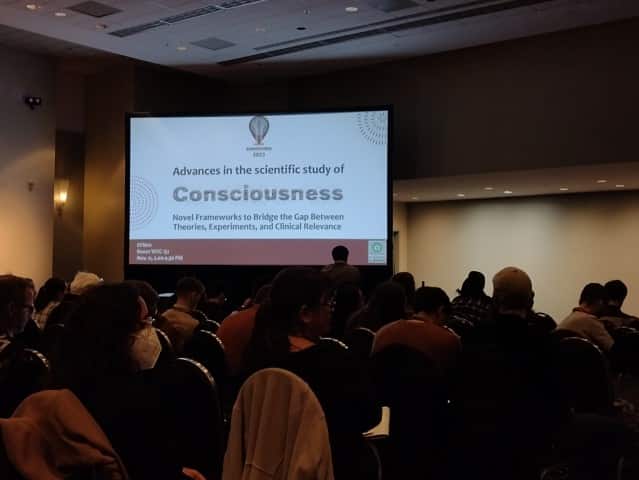
The Consciousness Symposium was also very interesting. This is a ripe field of science, with elaborated lines of research and well-defined boundaries of study. Scientists were filling in the missing pieces and mostly validating each other’s study and line of thought.
Unfortunately, neither of the sessions was recorded or had an article in the Journal of Neuroscience. I would have loved to view them for a second time, or read up on it.
Nano symposium Learning and Memory
I felt totally at home at a Nano symposium on Learning and Memory, because all presentations were really easy to follow . Experiments done in the lab are really connected to my work in practice, with learners with learning challenges. As a result and suddenly I felt a real neuroscientist in that field.
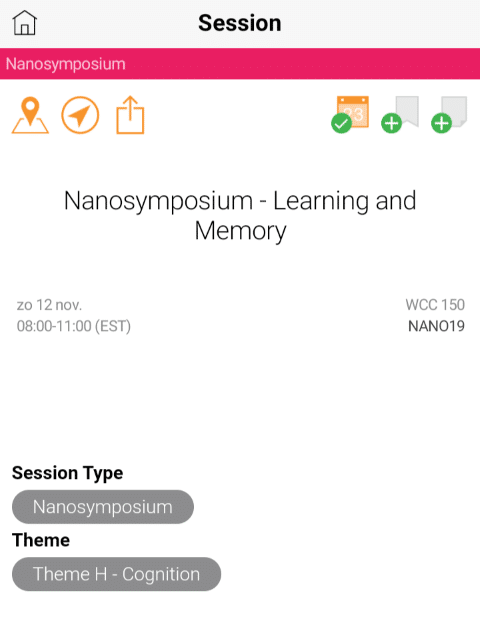
In this symposium scientific insight was presented for learning strategies that I have taught to learners with learning challenges.
For instance that presenting information on the same location facilitates learning. Publishers of textbooks are using it to facilitate learning. In their method they are presenting important information at comparable locations in the textbooks, facilitating learning and thus selling their product. (Presentation: Overlap between events has different consequences for learning and memory when events overlap in location versus content information -B. CHALOUPKA, D. ZEITHAMOVA)
Teaching learners to use spaced learning is also a learning strategy that is taught. In this symposium, the scientific fundamental for this memory promoting learning strategy is presented. (Presentation: Spaced learning over long timescales strengthens stimulus-specific representations in vmPFC -F. ZOU, B. A. KUHL, S. DUBROW, J. HUTCHINSON)
Other very useful presentations for me where at that symposium.
From this symposium there is an abstract from all the different presentations in the symposium. That is wonderful. All posters have abstracts online. Symposia usually do not have separate abstracts; only an abstract on the complete symposium. This is a very welcome exception.
This symposium has an article in the Journal of Neuroscience (Common Mechanisms of Learning in Motor and Cognitive Systems)
Plenary Lectures
There are several type of lectures: Featured lectures and special lectures all lasting about 1:10 hours. They are really very good giving a broad overview of state-of-the-art neuroscience without going into overwhelming details.
For instance:Presidential Special Lecture:
Receptors, Synapses, and Memories — Richard L. Huganir.
That lecture was enlightened by anecdotes from the presenter’s scientific life of 40 years. It is meant to be useful for trainees to see the full arc of somebody’s career. His career spans from his behavioural research on colour preference in mealworms at primary school. After that his goldfish experiments on memory and protein synthesis in high school. Finally to his scientific work on receptors of the synapse.
His thesis was on the nicotinic receptors in Torpedo californica (an electric ray). These anecdotes set the stage for the scientific talk. They lighten the mental atmosphere of the audience, this makes the scientific content of the lecture more accessible to attentive listeners.
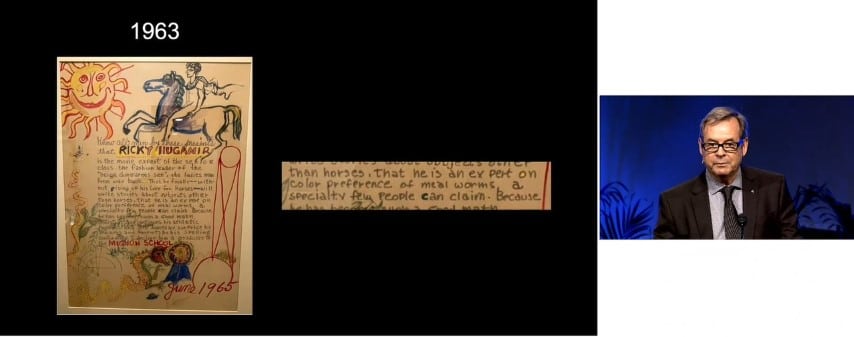
In the last few years, he and his lab focussed on AMPA receptors as they mediate 90% of excitatory synaptic transmission in the brain. His research results have led to a deeper understanding of synaptic plasticity, LTP, and memory. They study the proteins that interact with AMPA receptors and may be regulating the properties of these receptors.
Protein, SynGAP, was the object of research. They used mice in which the SynGAP 1 gene was deleted. Homozygote mice for this deletion die. Heterozygotes live and breed relatively well but have severe difficulties in learning and memory; they show behaviour abnormalities and they have seizures.
The importance of fundamental research to society
In 2009, a paper came out on SynGAP mutations in three children with intellectual disabilities. After that there appear to be hundreds of thousands of these children. They have intellectual disabilities, seizures, and autistic repetitive behaviour. Mutations in SynGAP occurs in 1% of individuals with intellectual disability. Heterozygote SynGAP knockout mice model these kids remarkably well.
Prof. Huganir is strongly connected with the patient association of children with SynGAP mutations and their parents. You can see an example of this in this video of the SynGAP Research Fund were he is talking about the Rescue of SynGAP expression .
I find this a striking example of the importance of fundamental science in our society. We need more than just applied science.
In his summary, prof. Huganir points out that therapeutic approaches should focus on increasing the expression of SynGAP from the normal allele in these children.
Virtual component of the meeting and abstracts for lectures
Several scientific sessions were livestreamed and these recordings, and the virtual posters, are available for attendees until December 15th. This makes it possible to go back to a lecture that you have been at and learn from it in depth. During the meeting it also makes it easier to choose between two events that you are willing to attend that are at the same time. If one of them is recorded you can go to the other and watch the recorded one later.
It is a shame that only Posters always have abstracts. Lectures usually do not have them and symposia usually only have an abstract describing the content of the symposium, not of the individual presentations. A good exeption to this rule is the symposium on Learning and Memory. There, the individual presentations have a unique abstract. I think all the symposia should have that.
Some symposia have an article in the Journal of Neuroscience (Vol 43, Issue 45). Only one Symposium I went to mentioned this (the symposium on Cognitive-Affective Functions of the Cerebellum.) There were free printed copies of this issue available at the meeting.
Amazing experience
Attending annual meeting SfN2023 has been an amazing experience again, like it was in 2019 (Visiting the annual meeting of the Society for Neuroscience 2019) and 2017 (Looking back on SfN2017) This time I can continue learning through the Virtual Content of recorded lectures and Virtual Posters until December 15th.
Thanks prof. White for giving me the possibility to attend. I’m already looking formard to the annual meting next year, SfN2024 in Chicago.